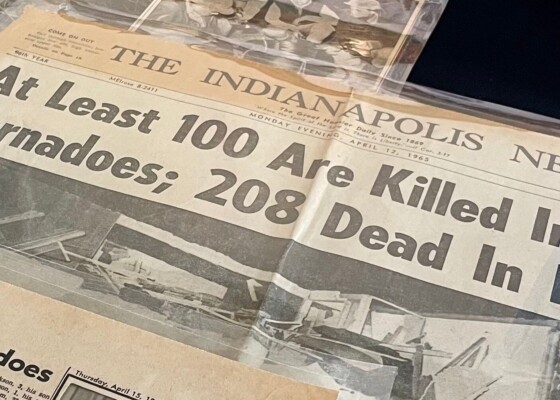Six Questions with Joseph Tucker Edmonds
October 31, 2022We met with Joesph Tucker Edmonds, Associate Professor of Religious Studies and Africana Studies at IUPUI, to talk about his work, passions and experiences. What’s a concept worth understanding? I…
We met with Joesph Tucker Edmonds, Associate Professor of Religious Studies and Africana Studies at IUPUI, to talk about his work, passions and experiences.
What’s a concept worth understanding?
I think a concept that is worth understanding is misogynoir or misogyny noir, which means, or is connected to the two terms misogyny and noir and is thinking about a deep hatred or a deep disregard for black women and the ways in which it plays out in popular culture.
As a thinker and a studier of the black body. I talk and think a lot about how black bodies are represented in popular culture, and we see over and over again the representation of black women in popular culture. It’s something that we need to think about and unpack, and I think that this term does a good job of looking at the ways in which this deep disregard, this deep hatred or deep concern for black women plays out in our popular culture. Think of the examples of someone like Serena Williams or Michelle Obama and the ways in which their bodies and their perspectives are quickly and fully disregarded or challenged by the popular culture or the popular media.”
What’s a book worth reading?
There are a lot of books that I love, and I’m going to start with a couple, and the reason that I want to start with a couple is that I want to talk about three books that look at Black men’s interior lives. One would be The Lonely Letters By Ashley Crawley, which is an amazing book that is about a scholar who is writing letters to his younger self. That is just fantastic. I would talk also then about The Nickel Boys by Colson Whitehead and then finally, I would look at The Fire Next Time by James Baldwin, and I think all three of those books, I know you asked for one, but all three of those books look at the interior lives of black men, the ways in which they deal with emotional and psychological wellbeing and wellness, and are asking the question of what it means to not only persist or be resilient in our culture but what it means to flourish and to do well.
What’s an activity worth doing?
I think that one of the activities that are so worth doing, especially here in the United States, is to go and to visit one of the former enslavement plantations in the American South. And I often tell people that not because I want people to go back to the trauma or to the violence and the real damning work that has been done against and on black people’s lives and black people’s bodies, but I want people to also see the ways in which black and African culture was built and sustained in those places. How the formerly enslaved Africans and African Americans built cultures and religions, the ways in which they sustained families and communities, and the ways in which they resisted and created opportunities for joy and for loving and for excitement that oftentimes those stories are not told. And so I would encourage folks to visit those places.
What’s a podcast worth listening to?
I love, right now, the podcast that I’m listening to is called Black Girl Songbook by Danielle Smith, and it is amazing. She is a writer, a music editor, and she just provides amazing way to look at the history and the stories of black women and music, and she looks at it particularly through songs and through particular moments in history. But she does this amazing work of just tying in stories and connecting them to other political and cultural events, inviting these artists to come in talking about their for bearers and ancestors, but also the ways in which they impact other culture that is going on right now. The other podcast, if I could just add one more, would be Still Processing by Wesley Morris and Jenna Wortham, from the New York Times. It is an amazing podcast. So both of those are looking at black popular culture, the ways in which they’ve been shaped by African and African American history, and the ways in which they continue to persist and to change and transform the democratic society that we live in today.
What’s a video worth watching?
Now, this is hard for me because I’m a Gen Xer, and I know that we don’t watch short form videos in the same way that some of my more contemporary listeners might be watching today. But I had to point out that the video that I would say was watching is the second episode of Queen Sugar. Now, I know that it’s a long form video, and I suggest you watch the whole series. Queen Sugar is a masterclass in my mind of shooting and looking at the land that was inhabited by African and African Americans in the South, particularly Louisiana, the lighting of black and brown people. The story of owning and working and living on the land and looking at the interior lives of black men and women and taking a slow, steady, and really interior look at the ways in which that impacts our culture, our lives, our loves. It is a show and a set of videos that are worth watching. So if you can’t watch the whole series, watch the second episode of the first season of Queen Sugar.
What’s an Indiana worth imagining?
An Indiana worth imagining is an Indiana where the lives and the stories of indigenous people and of black and brown folks who have been an integral part of this city and this state are visible everywhere that you go. I really imagine in Indiana where we don’t have to dig so deep and work so hard to figure out and hear the stories of black and brown and indigenous folks. I imagine that in our downtown, amongst our tallest buildings and our biggest Fortune 500 companies, we would see it on our college campuses that we would be enveloped by, but that as we walk and make our way through the neighborhoods of Indianapolis, not only the historic African American ones and the places on which indigenous people live, but even in those places that have been redlined, those places where folks have been pushed out, that we would be able to hear and see those stories.
So I want books and images. I want audio. I want pictures of that to surround our city and our state so that everyone who comes here would know the full story and the full history of Indiana, and not just specialists and not just folks who are actively and specifically seeking that kind of knowledge.



